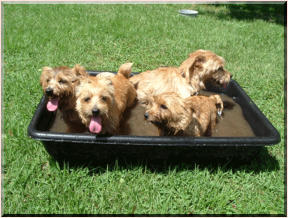


Fun With Your Norfolk Terrier




Jumping. Make your own agility or flyball hurdle by placing a broom or PVC pipe across two plastic buckets. Hold a treat on
one side, and encourage your dog to jump over.

Flygility: Flygility is a dog sport that mixes elements of agility and fly ball. As in flyball the dog is sent to fetch a ball from a
flyball machine and returns the ball to the handler. Courses are longer, 30m from start line to the box, and use agility
obstacles. The sport is administered by New Zealand Flygility Dog Association. More...

Activity dog toys. There are many new treat toys on the market that make your dog think about how to get the treat
from them. These are great to occupy your dog and stimulate his or her mind. If you have to leave your house, these are
a great way to keep your pet occupied during bad weather or while you are gone.

Life Jackets for your pet: Spring is around the corner and our Norfolk love the water. Keep them safe when enjoying water
sports with their own life jacket. There are many other vendors who offer this life saving product.
Treibball - A New Dog Sport
Dog Parks, Dog Runs and Off Leash Play
Picture-Perfect Dog Photos






Go Find: Another "Find" Game:
"Go Find" is a more advanced version of the "Find the Treat" game. My very active dog Turbo very badly to learn some self
control and focus. This game helped him in a fun way. I started with an ordinary game of fetch . As a separte exercise I
introduced "stay". Then I put them together. Instead of throwing the ball I would tell him "stay" and I'd drop the ball. If he
stayed I told him "Yes" (my "clicker word") and tossed or kicked the ball to make it move and let him get the ball. If he grabbed
the ball without permission I would just turn my back for a few seconds and ignore him. Soon he was waiting for the "yes"
then diving for the ball. I started tossing the ball a little bit further each time. The toss was gentle and intended to be not
exciting ... at least at first.
Over a period of weeks I gradually increased the distance until he was able to wait while I threw the ball as far as I coud. Next I
would tell him "stay" and instead of throwing the ball I would walk ten or fifteen feet, then drop the ball, and then "yes"
release him to get it. Working this to a long distance didn't take long.
Next I dropped the ball behind a log, when he waited for the release "yes" I added the cue "Go Find". Soon I was walking 50
feet or so before dropping the ball behind a log and releasing him and saying "Go Find".
Next I played a trick on him. I only pretended to drop the ball. Instead I walked another ten feet and let the ball drop behind
the log when he couldn't see the ball leave my hand. He got to the place he thought I dropped it, didn't find it, but only had to
search a little to find it. Sometimes I would actually drop the ball, sometimes I would walk a bit before dropping the ball. Soon
he got the idea that he had to actually look for the ball. I walked three, four or five different places either pretending to drop
the ball or actually dropping the ball. Since he knew some were a trick he learned to check all the places.
The next stage involved leaving him confined out of sight while I put the balls behind the logs. Then I started putting the balls
in a variety of places, not just behind the logs but in the fence next to the log, in a bush, or under a cone. This game has
developed much more than these quick instructions.


- Behavior
- Honor Roll
- Living With Norfolk Terriers
- Fun With Your Norfolk
- Tip Of The Week
- Publications
- Therapy and Service Dogs
- Health & Nutrition
- Competition


- Books
- Clubs
- Collectibles, Gifts & Fun Activities
- Companion Animal Recovery
- Dog Show Superintendents
- Genetics
- Health Related Sites
- Canine Health Links
- Vaccination Protocols
- Animal Health Trust
- Online Mendelian Inheritance In Animals
- Univ. Of Cambridge Vet. School
- Canine Inherited Disorders Database
- All Creatures Veterinary Hospital
- A First Aid Kit
- Veterinary Pet Insurance
- AKC Pet Health Plan
- Cornell Univ. College of Vet. Medicine
- More Health Related Sites
- Independent Sites
- Pet Travel
- Training Your Puppy
- Publications


- Breeding Tips
- Breeding Tips Page One
- Breeding Tips Page Two
- Breeding Tips Page Three
- Breeding Tips Page Four
- Breeding Tips Page Five
- Breeding Tips Page Six
- Virus &The Pregnant Bitch
- Dog Neutering Video
- Vaccinations & The Pregnant Bitch
- Incontinence In The Pregnant Bitch
- Flagyl & The Pregnant Bitch
- Canine Reproduction
- Frozen vs Chilled Semen
- Modern Breeding Management
- Dialogue On Rasberry Leaves
- Monitoring Pregnancy
- Uses For Vaginal Cultures
- OFA & The Pregnant Bitch
- Breeding Tips Page Seven
- Breeding Tips Page Eight
- Breeding Tips Page Nine
- Breeding Tips Page Ten
- Breeding Tips Page Eleven
- Breeding Tips Page Twelve
- Breeding Tips Page Thirteen
- Breeding Tips Page Fourteen
- Genetics And Inheritance
- Rescue









